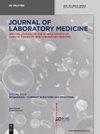无细胞DNA分析的兴起:从快照到时间基因组分析
IF 1.8
4区 医学
Q4 MEDICAL LABORATORY TECHNOLOGY
引用次数: 6
摘要
摘要不同来源的基因组以片段化无细胞DNA(cfDNA)的形式不断流入人体体液。这些分子保持着其原始来源的遗传和表观遗传密码,并经常在新发现的物理化学特征中携带额外的独特信息层。因此,cfDNA的表征提供了在计算机上非侵入性重建宿主和宏基因组主要部分的机会。来自单个样本的数据可以用来检测广泛的疾病特异性特征,并且已经能够开发出许多开创性的诊断测试。此外,来自连续采样的数据可能允许对时间基因组变化的鲜为人知的景观进行无与伦比的映射,因为它与个体不同生理和病理状态的各种变化有关。在这篇综述中,我们探讨了通过cfDNA分析获得的这一庞大的生物信息是如何被用于开发越来越强大的分子分析的,以及它是如何塑造新兴技术的。我们还讨论了这种对快照基因检测传统范式的背离如何为人类生物学中一系列令人兴奋的新发现铺平道路。本文章由计算机程序翻译,如有差异,请以英文原文为准。
The rising tide of cell-free DNA profiling: from snapshot to temporal genome analysis
Abstract Genomes of diverse origins are continuously shed into human body fluids in the form of fragmented cell-free DNA (cfDNA). These molecules maintain the genetic and epigenetic codes of their originating source, and often carry additional layers of unique information in newly discovered physico-chemical features. Characterization of cfDNA thus presents the opportunity to non-invasively reconstruct major parts of the host- and metagenome in silico. Data from a single specimen can be leveraged to detect a broad range of disease-specific signatures and has already enabled the development of many pioneering diagnostic tests. Moreover, data from serial sampling may allow unparalleled mapping of the scantily explored landscape of temporal genomic changes as it relates to various changes in different physiological and pathological states of individuals. In this review, we explore how this vast dimension of biological information accessible through cfDNA analysis is being tapped towards the development of increasingly powerful molecular assays and how it is shaping emerging technologies. We also discuss how this departure from traditional paradigms of snapshot genetic testing may pave the way for an onrush of new and exciting discoveries in human biology.
求助全文
通过发布文献求助,成功后即可免费获取论文全文。
去求助
来源期刊

Journal of Laboratory Medicine
Mathematics-Discrete Mathematics and Combinatorics
CiteScore
2.50
自引率
0.00%
发文量
39
审稿时长
10 weeks
期刊介绍:
The Journal of Laboratory Medicine (JLM) is a bi-monthly published journal that reports on the latest developments in laboratory medicine. Particular focus is placed on the diagnostic aspects of the clinical laboratory, although technical, regulatory, and educational topics are equally covered. The Journal specializes in the publication of high-standard, competent and timely review articles on clinical, methodological and pathogenic aspects of modern laboratory diagnostics. These reviews are critically reviewed by expert reviewers and JLM’s Associate Editors who are specialists in the various subdisciplines of laboratory medicine. In addition, JLM publishes original research articles, case reports, point/counterpoint articles and letters to the editor, all of which are peer reviewed by at least two experts in the field.
 求助内容:
求助内容: 应助结果提醒方式:
应助结果提醒方式:


